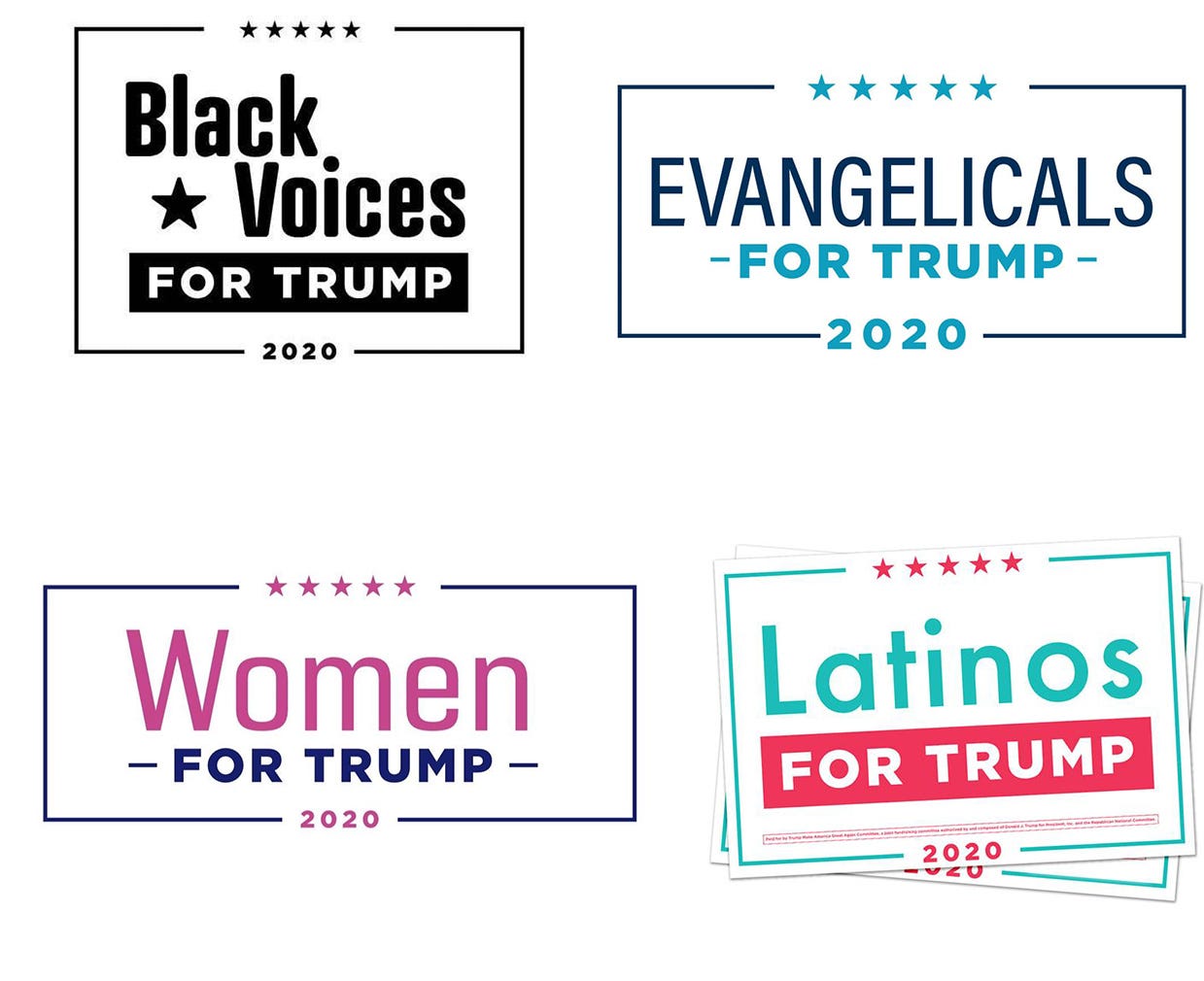The branding of Donald Trump

President Trump laid out his thoughts on logo design in the book Trump University Branding 101, from his for-profit real estate seminar program that would later pay $25 million as part of a settlement with former students who alleged it was a fraud.
“You do not need a graphic design house to develop your logo,” it read. “Ideally, your logo should be unique.”

Trump’s presidential campaign logo lives up to his advice. A superstar design firm hasn’t taken credit for it and it’s not particularly sophisticated, but it is recognizable and unique. The logo spells out Trump’s last name in Akzidenz Grotesk Bold Extended, one of the first widespread sans-serifs and a forerunner to Helvetica that was designed in 1896. It’s surrounded by a box topped off with five stars. The logo looks like an adaptation of Trump’s first presidential campaign logo, and since his 2016 victory, it’s quietly become one of the most influential logos in politics.
Trump’s business brand
One of the earliest Trump logos was the logo for Trump Tower. Written in 34-inch brass letters in Stymie Extra Bold, an industrial slab serif, the font was chosen by Trump Tower architect Der Scutt because he liked it. It was “a purely aesthetic decision,” he told Designer Observer in 2009. Scutt said the lettering was initially meant to be half as big, but Trump went behind his back and doubled its size. “I told him people flying into New York would see the sign before their planes landed,” Scutt said.

Credit: Ajay Suresh
The logo formed the basis of Trump’s emerging visual identity when Trump Tower opened in 1983. Versions of the logo appeared on other Trump products, including his 1987 ghostwritten book The Art of the Deal, but Trump’s business ventures didn’t adhere to a strict style guide. As his branded empire expanded across hotels, casinos, golf courses, and wineries, his logos grew.

Logos for Trump, Trump Plaza, and Trump Taj Mahal
The commonality among all of Trump’s logos is the color gold and the in-your-face, monster-truck-sized letters spelling out “TRUMP.” Visually, they communicated luxury and wealth. “I’d say this is appealing to the lowest level of human activity: envy and status” the late Milton Glaser told Fast Company in 2016 about the Trump Vodka bottle he designed a decade earlier.

Logos for Trump’s Indiana casino, the Trump Organization, and Trump Winery
Trump built his empire with his inheritance, debt, and aggressive self promotion. “You can have the most wonderful product in the world, but if people don’t know about it, it’s not going to be worth much,” he wrote in The Art of the Deal. He touted himself as a world-class builder and dealmaker, though he wasn’t always honest.
Later in the book, Trump admitted to exaggerating on purpose. “I play to people’s fantasies,” he wrote. “A little hyperbole never hurts.”
Subscribe to Yello for the latest news on the culture, branding, and visual rhetoric of politics, delivered each week:
Trump’s been accused of posing as his own publicist by using pseudonyms like John Miller or John Barron to leak flattering stories to the press. He lied and inflated his net worth to Forbes by hundreds of millions of dollars in an attempt to place high on their annual billionaires list.
“This was a model Trump would use for the rest of his career, telling a lie so cosmic that people believed that some kernel of it had to be real,” Forbes reporter Jonathan Greenberg wrote.
While Trump branded himself as uber successful, his tax records told a different story. Between 1985 and 1994, as Trump’s celebrity was first on the rise, he lost a total of $1.17 billion, nearly more than any other individual American taxpayer, according to a decade of tax information obtained by the New York Times. He’s had six bankruptcies, his Trump Shuttle airline was never profitable, and one analysis found he would be more rich today if he had just invested the money he inherited from his father.

Credit: Business Insider
“The Apprentice” rebrand
“The Apprentice” provided Trump with a comeback vehicle from his business woes when it premiered in 2004. The show was an early reality TV game show hit, reaching more than 20 million viewers in its first season, according to data from Nielsen.
“The Apprentice” was family friendly and it positioned Trump as part of a new class of reality television bosses who delivered scathing critiques and raw honesty to contestants, like “American Idol” judge Simon Cowell. “You’re fired” became Trump’s catchphrase and “The Apprentice” would become his stepping stone into politics.
Trump had become a pop culture figure in part by requiring he get a cameo in movies that were filmed in Trump Tower. His lifestyle inspired rappers to drop his name more than 300 times over 30 years, and Biff, the bully villain in “Back to the Future” who grows up to own a casino tower, was based on Trump. “The Apprentice,” though, took Trump’s celebrity to the next level.
“On TV, you feel you get to know the person,” Mark Burnett, the creator of “Apprentice” told the Washington Post. The show gave Trump the respect of Middle America and was the bridge to his campaign, former NBC publicity director Jim Dowd said.

The logo for the show was written in Impact, which was created by type designer Geoffrey Lee in 1965. The typeface is condensed and bold, with each character taking up a lot of space. “Use Impact in display situations requiring a strong statement,” advises Linotype, the company that sells the font. Impact later became famous for its use in image macros and was the quasi-official font of early internet memes.
Trump gets political
Trump made his first official foray into presidential politics just a few years before “The Apprentice.” After Reform Party candidate and former pro wrestler Jesse Ventura won the governorship in Minnesota in 1998, Trump attended a fundraiser for him.
Trump knew Ventura through Wrestlemania, and they had a private two-hour meeting about campaign strategy, according to WCCO in Minneapolis. Ventura provided Trump with proof a celebrity could run an anti-establishment campaign.
Trump’s 2000 logo was a precursor to his later presidential campaign logo in style, though not in exact font or tracking. The logo appears to have used Univers, another Linotype typeface, and the letters are much closer together. His 2000 flirt with politics was short-lived, though. Trump announced he wouldn’t run for the Reform nomination in February 2000 after Ventura left the party.

Trump’s 2000 campaign logo
Trump’s celebrity was crucial to his future political success. Adviser Roger Stone said the fact that everyone knew Trump was “the single most important quality for a candidate with Donald’s baggage.” “He was already a national figure,” Stone told New York magazine.
Trump was a continuation of a trend in American politics going back to JFK, of candidates marketing themselves and winning elections on the strength of their personal brand rather than their party connections, Bruce Newman, a professor of marketing at DePaul University and editor-in-chief of the journal Political Marketing, told Yello in an interview.
“If you go back to pre-marketing oriented campaigns, I would say, you go back to 1960 with John F. Kennedy, most would say he’s the first real marketed candidate that we had,” Newman said. “Since that point in time, each of these successive campaigns … [show] how marketing and branding have taken over the role of the political party.”
Trump jumped back into presidential politics in 2015 with heightened celebrity and a new logo, but the campaign wasn’t strict about how the logo was used. At rallies, the signage on Trump’s lectern could look different at different stops, which seemed par for the course for a candidate who didn’t use matching Gs in his “Make America Great Again” hats and who scrapped the original Trump-Pence logo because it was too suggestive.

Trump logos from his announcement speech, and rallies in Palm Beach, Fla., and Phoenix, Ariz.
Still, the box-and-stars look became a popular visual reference for Trump. MAGA teens in conservative communities used the style to ask each other out to high school dances, and Republican candidates for Congress used it in their own logos, like Jim Renacci in Ohio and conspiracy theorist Marjorie Taylor Greene in Georgia.
It also popped up among Democrats too. Andrew Yang’s campaign had signs and graphics with a blue background, red box, and white text using Montserrat, a typeface the Trump campaign uses in digital assets. Earlier this month, the Biden campaign account @teamjoebiden even had a digital graphic that looked oddly familiar.

Yang sign credit: Hunter Schwarz, President Biden graphic credit: @teamjoebiden/Instagram
The Trump campaign also uses the style to make logos for sub-brands targeting different constituencies. Groups like Black Voices for Trump, Women for Trump, Evangelicals for Trump, and Latinos for Trump all use different color schemes and typefaces to communicate in a different visual language than the main campaign, but the box and stars tie them together.

The success of Trump’s 2016 political brand was due in large part to his outsider status. He vowed to not be a typical politician and he made big promises, but you can only run that campaign once. Four years later, you have to deliver.
Trump has only kept about a quarter of his campaign promises, according to Politifact, and his most memorable ones, like “Build The Wall” and make Mexico pay for it, haven’t come true. Instead, Trump serves up misinformation. Rather than “Drain The Swamp,” his administration has been aggressively corrupt, with multiple advisers and associates being charged with crimes. He’s had to scrap his planned “Keep America Great” reelection slogan.
In The Art of the Deal, Trump wrote about why Jimmy Carter was a one-term president, and it basically came down to living up to your brand.
“You can’t con people, at least not for long,” he wrote. “You can create excitement, you can do wonderful promotion and get all kinds of press, and you can throw in a little hyperbole. But if you don’t deliver the goods, people will eventually catch on.”
Top image credit: Imagined Trump brand guideline mockup by Trevor Rowell

